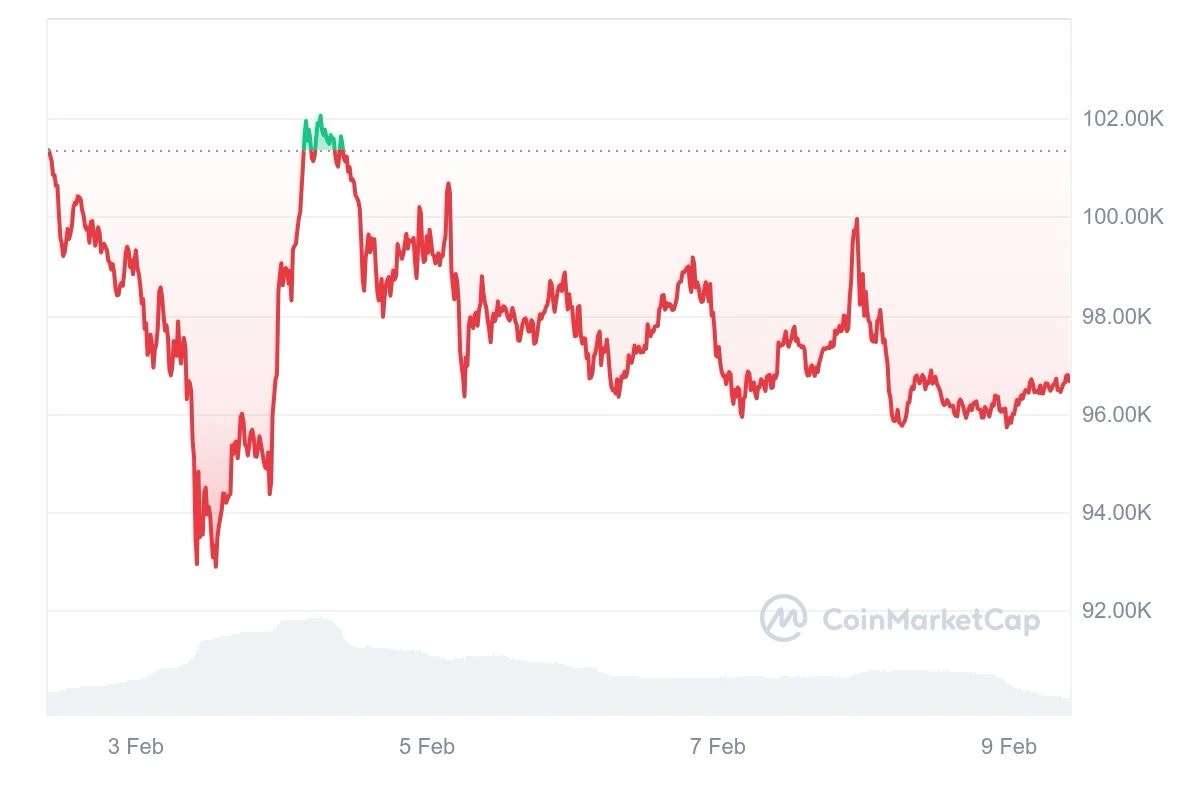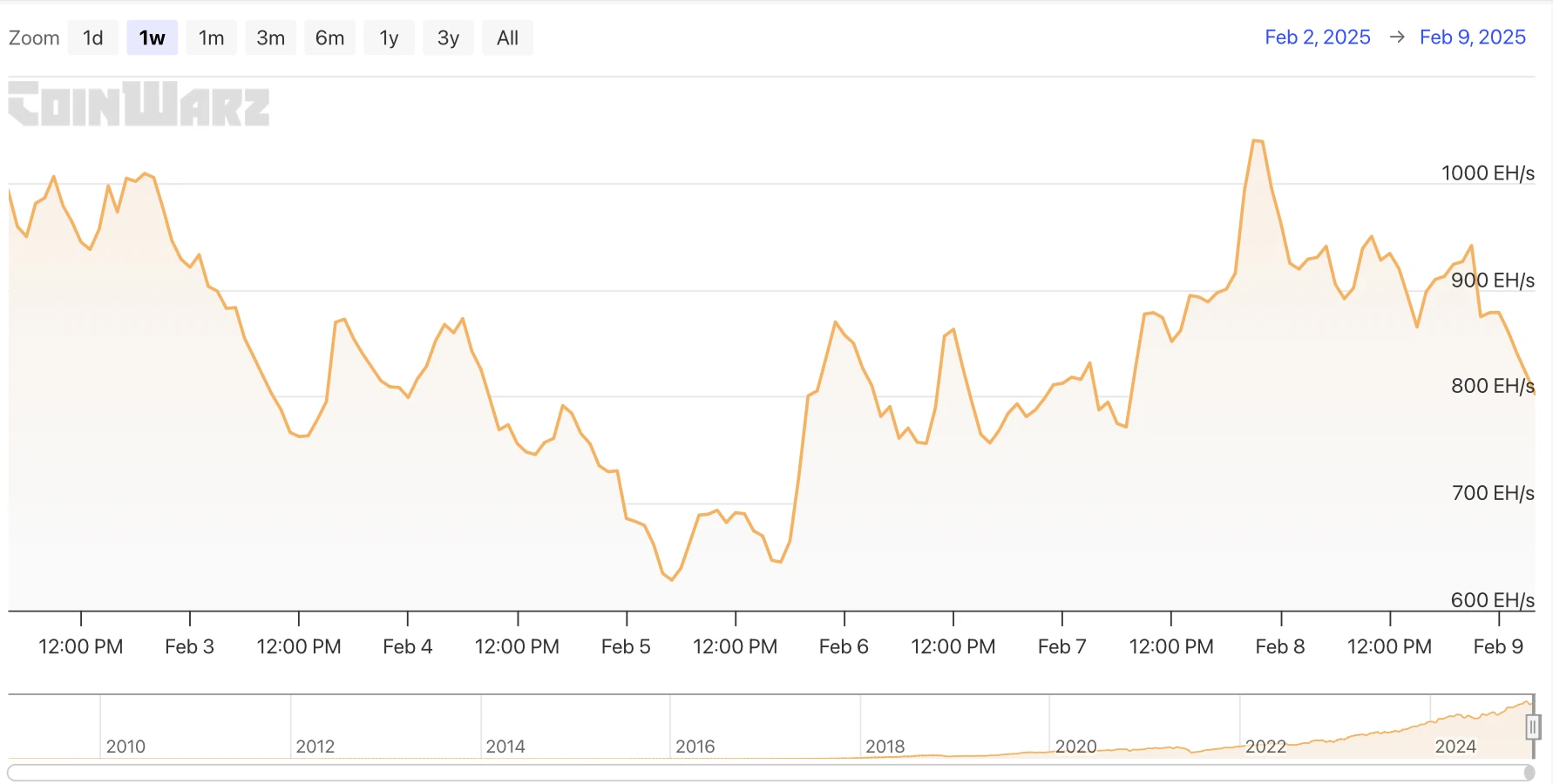
1. Bitcoin market and mining data
From February 3 to February 9, 2025, the price trend of Bitcoin is as follows:
From February 3 to February 4, Bitcoin continued to decline after opening, with the price fluctuating from $101,350 to a low of $92,935.16. After 22:00 in the evening, market sentiment warmed up, and the price rebounded rapidly, reaching an intraday high of $102,052.28 on February 4. It then fell back to a low of $97,963.3.
From the evening of February 4 to the morning of February 5, Bitcoin entered a narrow consolidation phase, with prices fluctuating between $98,000 and $100,000. At 3:35 a.m. on February 5, bulls briefly exerted their strength, pushing the price up to $100,677.01, but then quickly fell back to $96,344.45 and rebounded slightly.
From February 6 to 7, the overall market fluctuated in a range, with the price of Bitcoin fluctuating between $95,850 and $99,210. Near the close of the 7th, the bulls tried to break through, and the price briefly rose to $99,952.94, but failed to stabilize, and then quickly fell back to $95,747.76.
From February 8 to February 9, the volatility of the Bitcoin market tended to converge, and the price range narrowed further, fluctuating in a narrow range between $95,710 and $96,920. As of writing, Bitcoin is temporarily reported at $96,650. The overall trend continues to consolidate, the short-term volatility is limited, the market is in a wait-and-see mood, and the short-term direction is not yet clear.

Bitcoin price trend (2025/02/03-2025/02/09)
Market dynamics and macro background
Fund Flow
The Bitcoin market has experienced dramatic fluctuations, and capital flows have shown a cautious trend. On February 3, Bitcoin fell sharply, causing a liquidation of more than $2 billion, and market sentiment tended to panic. At the same time, on February 7, the spot Bitcoin ETF saw an outflow of about $66 million. Institutional investors such as Strategy stopped buying after 12 consecutive weeks of purchases, indicating that the market is waiting to see the current price. Overall, capital outflows and increased market volatility reflect rising short-term uncertainties. Investors need to pay attention to subsequent capital movements and market signals to cope with potential changes.
Technical Analysis
The technical side showed a wide range of fluctuations, and the short-term direction is still unclear. The price rebounded after forming a staged low of $92,935, but $102,052 became a key resistance, and the overall range was maintained between $95,710 and $96,920. The trading volume increased during the violent fluctuations and then fell back, indicating that the markets wait-and-see sentiment has increased. The RSI rebounded to a neutral level, and the short-term moving averages were glued together, indicating that the market entered a consolidation period, and the 50-day moving average provided some support. The implied volatility of options soared this week and then fell back, and the funding rate tended to be neutral, suggesting that the long and short positions are temporarily balanced, and the market still needs new driving factors to break the volatile pattern.
Market sentiment
The overall market sentiment tends to be cautious, and investors are more cautious. During the period of sharp price fluctuations, the Fear and Greed Index fell briefly, indicating that the markets short-term risk aversion sentiment increased, and then as prices stabilized, the index gradually recovered. Social media and derivatives market sentiment indicators show that there is a clear divergence between long and short sentiments, and investors lack consistent expectations for the short-term direction. The peak of trading volume is mainly concentrated in the sharp drop and rebound stages, indicating that there is still active buying in the market, but the selling pressure from above is still heavy. In addition, the slowdown in ETF fund inflows indicates that institutional investors have not actively increased their positions for the time being, and the overall market sentiment is in a state of cautious fluctuations, waiting for new macro catalysts.
Industry news and macro background
On February 3, the cryptocurrency market experienced a violent shock, with Bitcoin falling by more than 6% in 24 hours and Ethereum plummeting by 25%, triggering panic in the market. In addition, the National Bank of Poland explicitly stated that it would not include Bitcoin in its national reserves, citing concerns about security and stability, which also had a certain negative impact on market sentiment.
On February 1, US President Trump signed an executive order to impose a 25% tariff on imports from Canada and Mexico and a 10% tariff on Chinese goods. This move caused global market turmoil and the cryptocurrency market fell simultaneously. In addition, on February 4, Trump proposed a plan to take over Gaza, which further exacerbated geopolitical tensions and promoted risk aversion. Gold prices soared 9%, while Bitcoin performed relatively weakly.
Overall, the Bitcoin market this week showed high volatility due to the dual effects of industry dynamics and the macroeconomic environment. Investors should pay close attention to policy changes and geopolitical events to assess their potential impact on the Bitcoin market.
Hash rate changes
From February 3 to February 9, 2025, the Bitcoin network hash rate showed significant fluctuations. On February 3, the hash rate continued to fall from the previous days high of 1008.72 EH/s, reaching a low of 763.32 EH/s, and then rebounded slightly to 872.44 EH/s, and overall remained in the range of 760 EH/s to 870 EH/s. From February 4 to February 5, the hash rate further declined from 872.91 EH/s to a low of 628.16 EH/s this week. After February 5, the network computing power rebounded and climbed to 869.78 EH/s. On February 6, the hash rate fluctuated between 750 EH/s and 870 EH/s. From February 7 to February 8, the hash rate rose further, reaching a peak of 1039.65 EH/s this week, and then fell back to around 900 EH/s. On February 9, the hash rate fell back and remained around 800 EH/s at the time of writing. Overall, the fluctuation of the hash rate may be affected by factors such as miners income, mining difficulty adjustment, and changes in the market environment.

Bitcoin network hash rate data
Mining income
Since hitting an all-time high of around $109,000, Bitcoin has fallen by around 11.28%, causing miners to lose profitability and enter a very low-reward zone, facing the risk of capitulation. The halving event in April 2024 has increased the difficulty of mining, and coupled with the continued growth of the hash rate, competition among miners has intensified and profit margins have shrunk. Some miners have begun to actively sell Bitcoin to cover costs, and the flow of miners to exchanges has reached record levels. However, the Puell Multiple has remained above 1 since January 13, indicating that miners income is still relatively healthy. To avoid further capitulation of miners, the price of Bitcoin needs to recover and stabilize above $100,000 to ensure sustainable profitability for miners.
Energy costs and mining efficiency
On February 9, 2025, the Bitcoin network hashrate hit a new record, breaking through 810 EH/s to reach 818 EH/s. The Bitcoin network completed a new round of difficulty adjustment, and the difficulty of Bitcoin mining was raised to 114.17 T. As the difficulty adjustment occurs, the operating efficiency of miners is also optimized, thus affecting the overall energy consumption.
According to a research report by Canaccord Genuity, the mining cost of major mining companies is about $26,000 to $28,000 per Bitcoin. However, fluctuations in energy prices have a direct impact on mining activities. The recent rise in energy prices may lead to higher mining costs, which in turn squeezes miners profit margins. Some mining companies have improved mining efficiency through technology upgrades and operational optimization. The significant cost differences within the industry reflect the differentiated levels of mining companies in obtaining cheap electricity, improving operational efficiency, and managing capital. Some mining companies have low costs and high profit margins, while others operate at a small profit and are more vulnerable to Bitcoin price fluctuations.

Bitcoin mining difficulty data
2. Policy and regulatory news
Wu Jiezhuang: Hong Kong needs to speed up the study on the feasibility of incorporating Bitcoin into strategic reserves
On February 5, Hong Kong Legislative Council member Wu Jiezhuang posted on social media that the US AI and cryptocurrency tsar David Sacks and congressional Republican representatives held a press conference on February 4 to announce the establishment of a bicameral working group to formulate cryptocurrency regulatory regulations. Wu Jiezhuang pointed out that although Hong Kong has established a three-tier regulatory framework similar to that of the United States, including the Third Generation Internet Development Task Force, the Legislative Council Web3 and Virtual Asset Development Affairs Subcommittee, and the HKMA Stablecoin Regulatory Sandbox, it still needs to accelerate its development.
He made five suggestions: First, accelerate the feasibility of Bitcoin as a strategic reserve in Hong Kong; second, expand the authority of approved stablecoin companies in the sandbox and accelerate the implementation of applications; third, strive for national support to set up a stablecoin application pilot in the Greater Bay Area; fourth, relax the trading varieties of licensed virtual asset trading platforms; fifth, set up a digital asset office to promote the development of AI and virtual assets. Wu Jiezhuang revealed that he has been invited to participate in the Bitcoin US Summit held in Las Vegas in May, and will promote cooperation between the US and China in the cryptocurrency industry.
Several U.S. states have enacted laws to promote Bitcoin strategic reserves and investment bills
From February 6 to February 9, several US states (including New Mexico, Utah, Iowa, Missouri, Kentucky, Maryland, Florida, and Montana) successively proposed or promoted Bitcoin-related bills, involving the establishment of strategic Bitcoin reserves, allowing state governments to invest in Bitcoin, and expanding the application of Bitcoin in public finance. Among them, New Mexico proposed to invest 5% of public funds in Bitcoin, the Kentucky bill allows investment of up to 10% of state funds, and Montana authorizes investment of up to $50 million in Bitcoin.
Czech President signs new bill, exempting capital gains tax for holding Bitcoin for more than 3 years
On February 6, according to Bitcoin Magazine, the Czech President officially signed a bill stipulating that holding Bitcoin for more than 3 years will be exempt from capital gains tax.
Germanys AfD wants to leave the euro and relax Bitcoin regulations
On February 7, Germany will elect a new parliament on February 23, which may have a profound impact on the financial industry of Europes largest economy. Among them, the far-right Alternative for Germany party ranked second in the polls, but the mainstream German parties refused to cooperate with it in any government, which means that its proposals may never be realized. Nevertheless, their financial policy plans are the most specific and radical. The Alternative for Germany party called for Germany to withdraw from the euro zone, supported extensive deregulation of Bitcoin, wallets and transactions, opposed the digital euro, and so on.
3. Mining News
Russia plans to create mandatory registration agency for cryptocurrency mining equipment
On February 3, the Russian Ministry of Energy announced today that it plans to establish a single registration agency for cryptocurrency mining equipment, forcing all cryptocurrency mining operations to register. TASS reported that if the plan is implemented, cryptocurrency mining without equipment registered in the system will be impossible.
The initiative, led by Deputy Energy Minister Yevgeny Grabchak, is part of a proposed amendment to existing mining regulations aimed at better identifying domestic mining activities, especially those held in areas where mining is not permitted.
Mining company Stronghold fined $1.4 million for violating electricity market rules to mine Bitcoin
On February 5, it was reported that mining company Stronghold Digital violated energy market rules while prioritizing the development of Bitcoin mining business. The company agreed to pay more than $1.4 million in fines and refunds.
Stronghold is contractually obligated to provide available power to the PJM grid to help ensure grid reliability. However, FERC’s Office of Enforcement determined that Stronghold failed to meet this obligation between June 2021 and May 2022 and instead diverted power to its bitcoin mining operations.
Russia issues new cryptocurrency mining regulations, requiring miners to report their income by the 20th of each month and establish a national miner registration system
According to Bitcoin.com News on February 6, Russia officially released new rules for cryptocurrency mining, which explicitly require miners to report their mining income to the government before the 20th of each month, and stipulate that only entities approved by the government can legally engage in mining business. In addition, the Russian government explicitly prohibits any individual or enterprise with a record of financial crimes from participating in cryptocurrency mining in order to strengthen industry supervision and prevent financial risks.
An important part of the new regulations is the establishment of a national miner registration system, which will register all miners and may involve the collection of miners personal information and encrypted wallet addresses. In this regard, the Russian Bitcoin miner community has expressed strong concerns. According to Cryptoslate on February 8, Russian MP Anton Gorelkin warned on Telegram that the system may bring serious security risks, especially once the miners wallet addresses are leaked, they may be used by geopolitical opponents, posing a threat to the security of miners funds. Gorelkin pointed out that considering the current international sanctions environment, Russian Bitcoin miners face potential external strikes, and these new regulations may increase their compliance costs and operating pressures.

Related images
4. Bitcoin related news
Bitcoin holdings of global companies and countries (statistics for this week):
El Salvador: holds 6,056.18 BTC, equivalent to approximately $586 million.
Genius Group: holds 440 BTC with a total value of US$42 million and an average purchase price of US$95,519 per BTC.
Bitcoin Depot: holds 71.5 BTC, with 51 BTC added this week and an additional $5 million worth of BTC purchased.
Remixpoint: holds 509.33 BTC, with 30.83 BTC added this week, and the increase amount is approximately US$3.22 million.
Semler: holds 871 BTC, with a total purchase amount of US$88.5 million, an average purchase price of US$101,616 per coin, a return of 152%, and a return of 22% since the beginning of the year.
Metaplanet: holds 1,700 BTC, and the companys stock price hit an 8-year high.
Canaan Technology: holds 1,293 BTC.
Semler Scientific: holds 3,192 BTC, increased by 871 BTC.
Neptune Digital Assets: holds 376 BTC, increased by 20 BTC.
CleanSpark: 10,556 BTC added.
Bank of America: Holds $24 million in Bitcoin ETF, up from $14 million previously.
Strategy (formerly MicroStrategy): holds 471,107 BTC, with a market value of approximately US$46.612 billion, a total corporate market value of US$84.966 billion, and its stock price has risen 586% in the past year.
Bitfinex: The Bitcoin market is undergoing a structural change, but institutional investors continue to increase their holdings, showing market resilience
On February 3, BitfinexAlphas latest report showed that the Bitcoin market is undergoing a structural change. Although the price of BTC fell below $100,000 due to Trumps tariff policy, institutional investors continued to increase their holdings, showing market resilience. MicroStrategy increased its holdings of 10,107 Bitcoins with $1.1 billion, bringing its total holdings to 158,400, and submitted a financing application to the SEC to prepare for future increases; Japanese listed company Metaplanet completed $745 million in financing to expand its Bitcoin reserves to hedge against the risk of yen depreciation. In January 2025, BTC recorded a 10% increase, and the price has been consolidating in the 15% range for nearly 65 days.
At the macro level, Bitcoins correlation with traditional markets has increased, with the 30-day correlation with the SP 500 reaching 0.8, a 5-month high. The Federal Reserve maintained interest rates at 4.25%-4.50%, inflation remained above the 2% target, and core PCE remained at 2.8% year-on-year. At the same time, Tether is integrating its $140 billion USDT into the Bitcoin Lightning Network, improving network payment efficiency through TaprootAssets technology, and promoting Bitcoins transformation from a value store to a payment network.
Analyst: Sovereign nations will hoard gold and Bitcoin as economic buffers
On February 3, analysts at brokerage firm Bernstein said in a report to clients: If tariffs mean a stronger dollar, rising inflation, and a weakening outlook for interest rate cuts in the short term, then this means a decline in global liquidity for risky assets. From a longer time frame, as governments take on higher debts and higher deficits, leading to further currency depreciation, Bitcoin has relative value relative to the U.S. dollar, which is evident in Bitcoins long-term compound history. But in the short term, Bitcoin is correlated with risky assets. Therefore, the sell-off in cryptocurrencies is not surprising.
Bernstein analysts believe that in the long run, the Trump administration believes that cryptocurrencies are strategically important to government governance and national finances, aiming to control inflation by reducing deficits, cost-cutting departments of the government efficiency department led by Elon Musk, and increasing energy production. While foreign governments may retaliate against tariffs by selling U.S. Treasuries, Bernstein expects sovereigns to hoard gold and Bitcoin as economic buffers, and the United States will lead the shift to support cryptocurrencies, and more countries may follow suit.
CryptoQuant analyst: It is recommended that the investment ratio of altcoins should not exceed 10%, and the volatility of Bitcoin itself is enough to generate considerable returns
On February 5, CryptoQuant community analyst Maartunn pointed out that while Bitcoin only fell by 7%, altcoins showed a larger decline. It is recommended to control the investment ratio of altcoins between 5-10% based on personal risk tolerance.
Maartunn said that the current strategy of many investors to hold only altcoins and no Bitcoin would subject their portfolios to excessive volatility, while Bitcoin itself is volatile enough to generate significant returns, especially compared with traditional financial markets.
Standard Chartered predicts Bitcoin will rise to $500,000 during Trumps term
On February 5, according to Decrypt, Standard Chartered predicts that Bitcoin will rise to $500,000 during Trumps term, close to half of the market value of gold. BTC is expected to reach $200,000 in 2025, $300,000 in 2026, $400,000 in 2027, and $500,000 in 2028, with a total market value of $10.5 trillion. The main driving factors include the Bitcoin spot ETF attracting $39 billion in inflows, the improvement of the US regulatory environment, and the Trump administrations consideration of establishing a national digital asset reserve. Standard Chartered believes that as volatility decreases, the proportion of Bitcoin in investment portfolios will increase, attracting more traditional investors and driving long-term gains.

Related images
Sygnum: Every $1 billion in strategic Bitcoin reserve purchases could drive $20 billion in market value growth
On February 6, Katalin Tischhauser, head of investment research at Swiss crypto bank Sygnum, released a latest research report, predicting that for every $1 billion invested in the U.S. strategic Bitcoin reserves, the multiplier effect will drive the Bitcoin market value to grow by approximately $20 billion.
The report points out that due to the limited supply of Bitcoin liquidity, the new demand will trigger a significant upward price shock, of which $19 billion of growth will come from demand shock and limited supply squeeze effect. Tischhauser said that the first and second rounds of $1 billion in inflows will mainly absorb existing demand, while the third and fourth rounds of inflows will face a more limited supply environment, thus accelerating price increases.
BitRiver analyst: Bitcoin will reach $160,000 by the end of the year
On February 7, BitRiver financial analyst Vladislav Antonov said that the price of Bitcoin is expected to continue to grow to $130,000 in March-April 2025, and to $160,000 in October-November 2025. This forecast depends on favorable financial and regulatory developments, as well as positive geopolitical developments.
Grayscale Research Director: Bitcoin Could Hit New Highs in Q1 Despite Disappointing Job Data
On February 8, Cointelegraph reported that although the pace of U.S. hiring in January was lower than expected, Grayscale Research Director Zach Pandl said in an interview that Bitcoin has the potential to hit a record high in the first quarter of 2025. On February 7, U.S. officials said the country added 143,000 jobs in January, slightly lower than expected.
Pandl believes that the latest U.S. jobs report may reinforce expectations that the Fed will pause rate hikes for a while, but is unlikely to lead to a substantial repricing. Pandl said: Bitcoin is likely to take the latest jobs report in its stride. Bitcoin and other digital assets are benefiting from a variety of policy-related tailwinds, including progress on stablecoin legislation. Therefore, he expects a bullish bias in the cryptocurrency market. He said: As long as the stock market remains stable, Bitcoin may hit new highs later this quarter.
Tether CEO: Quantum computing cannot threaten Bitcoin encryption system yet
On February 9, Tether CEO Paolo Ardoino posted on the social platform X that quantum computing is still a long way from posing a substantial threat to Bitcoins encryption system. He predicted that Bitcoin will add a quantum-resistant address feature before any serious threat emerges. All living people who can access their wallets will transfer their Bitcoin to the new quantum-resistant address.










